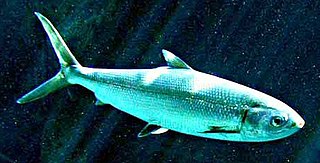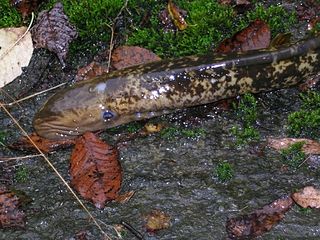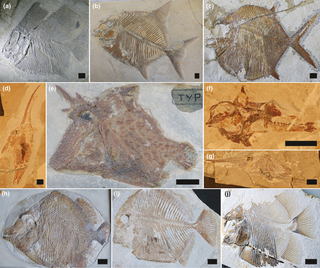
The Gonorynchiformes are an order of ray-finned fish that includes the important food source, the milkfish, and a number of lesser-known types, both marine and freshwater.

Chelidae is one of three living families of the turtle suborder Pleurodira, and are commonly called Austro-South American side-neck turtles. The family is distributed in Australia, New Guinea, parts of Indonesia, and throughout most of South America. It is a large family of turtles with a significant fossil history dating back to the Cretaceous. The family is entirely Gondwanan in origin, with no members found outside Gondwana, either in the present day or as a fossil.

Araucaria is a genus of evergreen coniferous trees in the family Araucariaceae. While today they are largely confined to the Southern Hemisphere, during the Jurassic and Cretaceous they were distributed globally. There are 20 extant species in New Caledonia, Norfolk Island, eastern Australia, New Guinea, Argentina, Brazil and Chile.

Gunnera is the sole genus of herbaceous flowering plants in the family Gunneraceae, which contains 63 species. Some species in this genus, namely those in the subgenus Panke, have extremely large leaves. Species in the genus are variously native to Latin America, Australia, New Zealand, Papuasia, Hawaii, insular Southeast Asia, Africa, and Madagascar. The stalks of some species are edible.

The sea lamprey is a parasitic lamprey native to the Northern Hemisphere. It is sometimes referred to as the "vampire fish".

Enchodus is an extinct genus of aulopiform ray-finned fish related to lancetfish and lizardfish. Species of Enchodus flourished during the Late Cretaceous, and there is some evidence that they may have survived to the Paleocene or Eocene; however, this may just represent reworked Cretaceous material.

Cyclostomi, often referred to as Cyclostomata, is a group of vertebrates that comprises the living jawless fishes: the lampreys and hagfishes. Both groups have jawless mouths with horny epidermal structures that function as teeth called ceratodontes, and branchial arches that are internally positioned instead of external as in the related jawed fishes. The name Cyclostomi means "round mouths". It was named by Joan Crockford-Beattie.
Mordacia mordax, known as the short-headed lamprey, Australian lamprey or Murray lamprey, is a species of Mordacia that lives in south-eastern Australia and Tasmania. Mordaciidae is made up of three species: M. praedox, M. mordax, and M. lapicida. M. mordax is a relatively rare, parasitic vertebrate and, along with the hagfishes, is part of the only surviving group of jawless organisms throughout vertebrate evolution. It has a thin eel-like body up to 50 cm (20 in) long, with two low dorsal fins on the back half. The skin is blue-gray or brown. Its eyes are small, and located on the top of its head.

Mordacia praecox, the Australian brook lamprey or nonparasitic lamprey, is a freshwater species of southern topeyed lamprey that occurs in south-eastern Australia. It has a thin eel-like body around 12 to 15 cm long, with two low dorsal fins on the back half. The skin is dark blue above and grey below. Its eyes are small, and located on the top of its head. Unlike M. mordax, M. praecox has eyes that appear to have the potential for dichromatic vision despite being similarly adapted for low-light environments.

Geotria is the only genus in the lamprey family Geotriidae. It has 2 known species: Geotria australis and Geotria macrostoma. Both species were considered conspecific until G. macrostoma was revived in a 2020 study.

Lampetra is a genus of lampreys in the family Petromyzontidae.

Mordacia lapicida, also known as the Chilean lamprey, is a species of southern topeyed lamprey endemic to southern Chile, where it can be found in riverine and marine habitats. This species is anadromous. This parasitic lamprey can reach a length of 54 centimetres (21 in) SL. Ammocoetes and adults of this species are found in rivers, and occur in fine sand along river banks. The life cycle of a Mordacia lapicida is divided into three life stages: freshwater rearing, an ocean parasite and an adult spawning stage. Once in the adult stage, individuals migrate into marine waters where they attack and attach themselves to marine fishes.

Pycnodontiformes is an extinct order of primarily marine bony fish. The group first appeared during the Late Triassic and disappeared during the Eocene. The group has been found in rock formations in Africa, Asia, Europe, North and South America. They were small to middle-sized fish, generally with laterally-compressed deep bodies, some with almost circular outlines, adapted for manuverability in reef-like environments, though the group was morphologically diverse. Most, but not all members of the groups had jaws with round and flattened teeth, well adapted to crush food items (durophagy), such as echinoderms, crustaceans and molluscs. Some pyncodontiformes developed piranha like teeth used for eating flesh. Most species inhabited shallow marine reef environments, while a handful of species lived in freshwater or brackish conditions. While rare during the Triassic and Early-Middle Jurassic, Pycnodontiformes became abundant and diverse during the Late Jurassic, exhibiting a high but relatively static diversity during the Early Cretaceous. At the beginning of the Late Cretaceous they reached their apex of morphological and species diversity, after which they began to gradually decline, with a more sudden decline at the end of the Cretaceous due to the collapse of reef ecosystems, finally becoming extinct during the Eocene. They are considered to belong to the Neopterygii, but their relationship to other members of that group is uncertain.

Brachypterygius is an extinct genus of platypterygiine ophthalmosaurid ichthyosaur known from the Late Jurassic of England. The type species was originally described and named as Ichthyosaurus extremus by Boulenger in 1904. Brachypterygius was named by Huene in 1922 for the width and shortness of the forepaddle, and the type species is therefore Brachypterygius extremus. The holotype of B. extremus was originally thought to be from the Lias Group of Bath, United Kingdom, but other specimens suggest it more likely came from the Kimmeridgian Kimmeridge Clay of Kimmeridge Bay, Dorset, UK.

Lampreys are an ancient lineage of jawless fish of the order Petromyzontiformes. The adult lamprey is characterized by a toothed, funnel-like sucking mouth. The common name "lamprey" is probably derived from Latin lampetra, which may mean "stone licker", though the etymology is uncertain. Lamprey is sometimes seen for the plural form.
The Caspian lamprey, Caspiomyzon wagneri, is a species of lamprey native to the Caspian Sea, and a member of the Petromyzontidae family. This species is a non-parasitic lamprey that feeds on animal carcasses.
Caspiomyzon is a genus of lamprey in the family Petromyzontidae. They are native to Eastern Europe and parts of Western and Central Asia. Two of the three species in the genus are endemic to Greece.
Mioceratodus is an extinct genus of lungfish in the family Neoceratodontidae, which also contains the extant Queensland lungfish. It is known only from Oligocene and Miocene-aged sediments in Australia, although phylogenetic evidence supports it having first diverged from its closest relative, Neoceratodus, during the Late Jurassic or Early Cretaceous period.
Praecox is a Latin term meaning "very early". It is often used as a qualifying adjective in Latin binomials, and could mean "early flowering", "primitive", "premature" or "early onset".

Arapaiminae is a subfamily of freshwater osteoglossiform (bony-tongued) fishes belonging to the family Osteoglossidae. It includes the South American arapaimas of the Amazon and Essequibo basins and the African arowana from the watersheds of the Sahelo-Sudanese region, Senegal, Gambia, and parts of Eastern Africa. This subfamily is sometimes raised to the rank of family, as Arapaimidae. A commonly used synonym is Heterotidinae, but according to the ICZN, Arapaiminae has priority.















